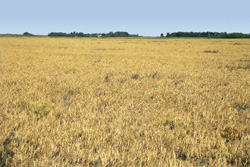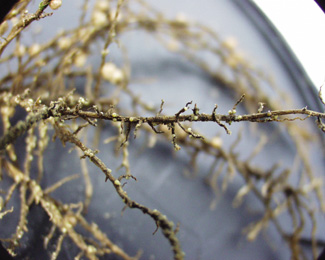
Features
Agronomy
Diseases
Good news! SCN is east of Toronto
No need for pessimism for some.
February 16, 2008 By Ralph Pearce
Hard to believe, but there are those involved in disease detection in Ontario who see the discovery of soybean cyst nematode (SCN) east of Toronto as a good news story for growers. The find was made in a soybean field north of Trenton in Northumberland County in the spring of 2007. The grower called Laura McCormack, a field agronomist with Pioneer Hi-Bred, who visited the field, collected soil samples and contacted provincial field crop pathologist Albert Tenuta, who confirmed the cyst population and made the bold statement of calling it a good news story.
 |
| The cysts of SCN infect the roots of the soybean plant, leaving stunted, yellow and dying plants standing in fields. |
The reason for Tenuta’s optimism is simply a matter of timing. In Ontario, growers in the southwestern part of the province have been growing soybeans in most regions for more than 30 years, and most of that time SCN has been an unwelcome, yet mis-diagnosed companion. “The overall impact to growers in eastern Ontario, as far as I’m concerned, is that if everything is done correctly, and we do have time, the effect should be very minimal compared to what we’ve seen in the southwest,” says Tenuta, who works with the Ontario Ministry of Agriculture, Food and Rural Affairs. “So in that sense, don’t think of it as a bad news story.”
Concern still there
It is not to say there were not remarkable points to the eastern Ontario discovery, however. Tenuta concedes there was considerable injury done by SCN in that particular field in 2007 and it would not surprise him if the most damaged parts of the field were not harvested. “Cyst populations on the roots were probably as high as what I’ve seen in southwestern Ontario, with the corresponding injury that we would have seen, as well, including a lot of stunted, yellow dead plants in those areas,” he explains.
“The indication would be that those cysts have been in the field for 10 to 15 years or more and have gone undetected, which is typical often of detections or new areas where we find cyst nematode. They often go undetected or undiagnosed and are allowed to build up, which is why SCN is often referred to as ‘the silent yield robber’.”
Still, there is the opportunity to create awareness in the region east of Toronto and Tenuta emphasizes that there is time to avert what has happened in southern Ontario. “It’s not a southwestern Ontario, light textured soil type of disease; it will adapt to all soil types, all soybean production regions, so eastern Ontario will not be excused from soybeans cyst nematode,” says Tenuta. “We can minimize the overall impact to producers just by creating awareness, and managing it through the very effective tools we have including resistant varieties, crop rotation and soil testing. The same holds true for other new SCN areas in the province.”
Following up
To help monitor the disease, McCormack collected six soil samples by the end of October 2007,
co-ordinating her efforts with Tenuta, with the hope of gathering additional samples between Toronto and Ottawa before winter weather settles in. “We did some sampling on that particular farm, and further tested their soybean fields but didn’t come up with anything else,” states McCormack, who is based in Whitby, Ontario. “We have tested a couple of suspect fields near Cobourg which came back negative, but we’re going to watch them pretty closely.”
Tenuta emphasizes that a negative test does not necessarily mean SCN is not present. It may be that the SCN levels are still very low or localized, and have not reached detectable levels. Often when a grower suspects SCN is reducing yields, it soon shows up, so they should trust their instincts.
 |
| Test results on one field in eastern Ontario indicated soybean cyst nematode levels high enough to suggest the disease has been present for up to 15 years. |
The samples McCormack took, along with others from eastern Ontario, are being added to a joint OMAFRA-CFIA SCN survey which is nearing completion. The survey targeted the Northumberland area as well in the winter of 2006/07 when preliminary soil test results detected another SCN field. Finding a different field in the same area illustrates the benefit of SCN testing and how sampling can be used in the monitoring and management of this very destructive disease. Tenuta believes it is reasonable to find other fields or areas in the east with SCN.
Of course, the other consideration for this discovery is the ‘How’ of its arrival and McCormack believes some of it could have come from the movement of equipment from southern Ontario to the east. “Some of it may have come in from the US a while ago,” she says. “We only have that one field that we know of, so when we get more fields tested and mapped in the fall of 2007, and get some more positives, we’ll be better able to trace it.”
Like Tenuta, McCormack also sees the SCN discovery in Northumberland as a positive. “We’ve caught it and we can manage it with rotation and resistant varieties,” she echoes. “So yes, definitely treat it as a good news story.” -end-
SCN soil testing laboratories in Ontario
1. A&L Canada Laboratories
2136 Jetstream Road, London, Ontario, N5V 3P5.
Phone: (519) 457-2575,
Fax: (519) 457-2664,
e-mail: aginfor@alcanada.com
2. Agri-Food Laboratories
503 Imperial Road, Unit 1, Guelph, Ontario, N1H 6T9.
Toll free: (800) 265-7175,
Phone: (519) 837-1600,
Fax: (519) 837-1242, e-mail: lab@agtest.com
3. Pest Diagnostic Clinic
(see also: Soil and Nutrient Laboratory) University of Guelph, PO Box 3650,
95 Stone Road West,
Guelph, Ontario N1H 8J7.
Phone: (519) 767-6299,
Fax: (519) 767-6240, e-mail: info@lsd.uoguelph.ca -end-
Management strategies
The same management strategies for soybean cyst nematode (SCN) listed in the 2002 edition of the Ontario Ministry of Agriculture, Food and Rural Affairs Agronomy Guide for Field Crops (Publication 811) apply today. The following are some quick tips for managing SCN. For more detailed information, check the latest edition of Publication 811 or the OMAFRA web site at: www.omafra.gov.on.ca/english/ crops/pub811/4scn.htm
The following are some of the recommended practices to help manage SCN and the potential for significant economic losses:
1. Plant certified or good quality, clean seed that is free of soil peds or aggregates;
2. Wash off soil from farm equipment when moving it between infested fields or farms;
3. Use proper soil conservation practices to reduce soil movement between fields;
4. Practice prudent weed control. Many weeds can be hosts to SCN;
5. Monitor SCN populations in the soil, with samples taken every two to three years, and egg count and total cyst count reported;
6. If SCN is diagnosed, establish a rotation that uses SCN resistant soybean varieties and non-host crops including corn, wheat, alfalfa, clover or a vegetable crop like tomatoes. -end-